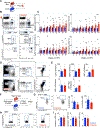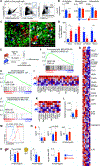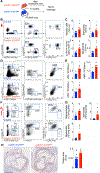Bone Marrow Endothelial Cells Regulate Myelopoiesis in Diabetes Mellitus
- PMID: 32316750
- PMCID: PMC7375017
- DOI: 10.1161/CIRCULATIONAHA.120.046038
Bone Marrow Endothelial Cells Regulate Myelopoiesis in Diabetes Mellitus
Abstract
Background: Diabetes mellitus is a prevalent public health problem that affects about one-third of the US population and leads to serious vascular complications with increased risk for coronary artery disease. How bone marrow hematopoiesis contributes to diabetes mellitus complications is incompletely understood. We investigated the role of bone marrow endothelial cells in diabetic regulation of inflammatory myeloid cell production.
Methods: In 3 types of mouse diabetes mellitus, including streptozotocin, high-fat diet, and genetic induction using leptin-receptor-deficient db/db mice, we assayed leukocytes, hematopoietic stem and progenitor cells (HSPC). In addition, we investigated bone marrow endothelial cells with flow cytometry and expression profiling.
Results: In diabetes mellitus, we observed enhanced proliferation of HSPC leading to augmented circulating myeloid cell numbers. Analysis of bone marrow niche cells revealed that endothelial cells in diabetic mice expressed less Cxcl12, a retention factor promoting HSPC quiescence. Transcriptome-wide analysis of bone marrow endothelial cells demonstrated enrichment of genes involved in epithelial growth factor receptor (Egfr) signaling in mice with diet-induced diabetes mellitus. To explore whether endothelial Egfr plays a functional role in myelopoiesis, we generated mice with endothelial-specific deletion of Egfr (Cdh5CreEgfrfl/fl). We found enhanced HSPC proliferation and increased myeloid cell production in Cdh5CreEgfrfl/fl mice compared with wild-type mice with diabetes mellitus. Disrupted Egfr signaling in endothelial cells decreased their expression of the HSPC retention factor angiopoietin-1. We tested the functional relevance of these findings for wound healing and atherosclerosis, both implicated in complications of diabetes mellitus. Inflammatory myeloid cells accumulated more in skin wounds of diabetic Cdh5CreEgfrfl/fl mice, significantly delaying wound closure. Atherosclerosis was accelerated in Cdh5CreEgfrfl/fl mice, leading to larger and more inflamed atherosclerotic lesions in the aorta.
Conclusions: In diabetes mellitus, bone marrow endothelial cells participate in the dysregulation of bone marrow hematopoiesis. Diabetes mellitus reduces endothelial production of Cxcl12, a quiescence-promoting niche factor that reduces stem cell proliferation. We describe a previously unknown counterregulatory pathway, in which protective endothelial Egfr signaling curbs HSPC proliferation and myeloid cell production.
Keywords: atherosclerosis; diabetes mellitus; hematopoiesis; monocytes; myelopoiesis.
Figures







Comment in
-
Response by Nahrendorf to Letter Regarding Article, "Bone Marrow Endothelial Cells Regulate Myelopoiesis in Diabetes Mellitus".Circulation. 2021 Jan 12;143(2):e7-e8. doi: 10.1161/CIRCULATIONAHA.120.051633. Epub 2021 Jan 11. Circulation. 2021. PMID: 33428432 Free PMC article. No abstract available.
-
Letter by Jian et al Regarding Article, "Bone Marrow Endothelial Cells Regulate Myelopoiesis in Diabetes Mellitus".Circulation. 2021 Jan 12;143(2):e5-e6. doi: 10.1161/CIRCULATIONAHA.120.049811. Epub 2021 Jan 11. Circulation. 2021. PMID: 33428436 No abstract available.
References
-
- Centers for Disease Control and Prevention. National Diabetes Statistics Report, 2020. Atlanta, GA: Centers for Disease Control and Prevention, US Department of Health and Human Services; 2020.
-
- Zheng Y, Ley SH, Hu FB. Global aetiology and epidemiology of type 2 diabetes mellitus and its complications. Nat Rev Endocrinol. 2018;14:88–98. - PubMed
-
- Booth GL, Kapral MK, Fung K, Tu JV. Relation between age and cardiovascular disease in men and women with diabetes compared with non-diabetic people: a population-based retrospective cohort study. Lancet. 2006;368:29–36. - PubMed
-
- DeFronzo RA, Ferrannini E, Groop L, Henry RR, Herman WH, Holst JJ, Hu FB, Kahn CR, Raz I, Shulman GI et al. Type 2 diabetes mellitus. Nat Rev Dis Primers. 2015;1:15019. - PubMed
Publication types
MeSH terms
Substances
Grants and funding
- R01 HL125428/HL/NHLBI NIH HHS/United States
- T32 HL076136/HL/NHLBI NIH HHS/United States
- R01 HL142629/HL/NHLBI NIH HHS/United States
- R01 HL134892/HL/NHLBI NIH HHS/United States
- R01 HL080472/HL/NHLBI NIH HHS/United States
- P01 HL142494/HL/NHLBI NIH HHS/United States
- R01 HL131495/HL/NHLBI NIH HHS/United States
- R35 HL139598/HL/NHLBI NIH HHS/United States
- R00 HL121076/HL/NHLBI NIH HHS/United States
- R01 HL143967/HL/NHLBI NIH HHS/United States
- R01 NS108419/NS/NINDS NIH HHS/United States
- K99 HL151750/HL/NHLBI NIH HHS/United States
- R01 NS084863/NS/NINDS NIH HHS/United States
- K99 HL121076/HL/NHLBI NIH HHS/United States
LinkOut - more resources
Full Text Sources
Molecular Biology Databases
Research Materials
Miscellaneous

